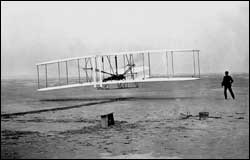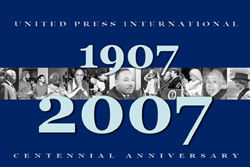1907 - 1910
1911 - 1920
1921 - 1930
1931 - 1940
1941 - 1950
1951 - 1960
1961 - 1970
1971 - 1980
1981 - 1990
1991 - 2000
2001 - Today
|
 |
UPI Archives
Wednesday, Sept. 9, 1908
Wright shatters airship records
 |
|
Orville Wright pilots the first flight as brother Wilbur runs alongside at 10:35 a.m. on December 17, 1903 at Kitty Hawk, North Carolina. The plane had just left the track at left for a flight that lasted 12 seconds and went about 120 feet. The classic image of 100 years ago was shot by John Daniels after receiving a quick photography lesson from Orville. This was the only picture ever taken by Daniels, a member of the nearby Kill Devil Hills lifesaving station. (UPI Photo/John Daniels/National Archives/Files)
|
WASHINGTON, Sept. 9, 1908 (UP) - Orville Wright, one of the famous Dayton, Ohio, brothers, and America capture the honor of accomplishing the most marvelous feat in aviation yet recorded.
The Wright aeroplane, operated by the aviator, whose brother Wilbur has been conducting successful tests in France, sailed Wednesday over and around the army parade ground at Fort Myer, Va., 57 minutes and 31 seconds. This exceeds by more than 26 minutes the hitherto world-breaking record made Monday by Delagrange near Paris.
Wright plans another flight Wednesday afternoon to break his record. "I know there's more in the machine," he said. He cried with joy over his success.
During the flight the aeroplane maintained an average speed of about 38 miles an hour, only two miles an hour less than required under the government contract for speed on a straightaway course.
This performance insures the acceptance of the aeroplane by the United States government at the contract price of $25,000.
"I could have remained up 15 minutes longer," said Wright, as he alighted. "I still had some gasoline left. The motor worked almost to perfection, there being only an occasional slip. I shall try another flight as soon as I can load up the gasoline tank and look over the engine."
The flight started at 8:15. Weather conditions could not have been more favorable. The sun was shining brightly, the atmosphere was crisp and exhilarating, and only a slight breeze was blowing.
A crowd of army and navy officers and citizens had gathered in the parade ground. Sailing along at express train speed, the bird-like craft responded immediately to the slightest touch of the steering lever and maneuvered higher or lower as the planes were managed by the operator.
Fifty-eight times Wright circled around the course, while the spectators breathlessly followed its evolutions.
A rousing cheer went up as the minutes sped by. When the aeroplane gently descended and alighted every person shouted congratulations to the aviator.
Unfortunately the anemometer, relied upon to register the speed, did not work, and no exact data is available as to the rate. Observers who have witnessed previous flights expressed the opinion that it reached 38 miles an hour, and, computing the distance of the parade ground circuit with the rate of speed, it is estimated that during the 57 minutes and 31 seconds of his flight Wright covered a distance close on to 40 miles.
Since the present tests began Sept. 4, the machine had not reached a greater altitude than 50 feet. Just to show its possibilities, however, Wright soared up occasionally to double that height, and at one time reached 120 feet in Wednesday's test.
Under the terms of the government's agreement with Wright in the tests the aviator was to have until the last of the month to comply with the government's requirements as to speed and endurance. The machine was to make a speed of 40 miles an hour on a straightaway course of five miles and return, and was to be able to remain in the air one hour.
Although Wednesday's test for endurance was not official, government officers who saw the remarkable flight have no doubt that Wright can duplicate the feat any time.
Wright was not striving for speed, and necessarily had to lower the momentum in taking the curves around the parade ground.
The aeroplane, which is an improvement on the one now being tested in France by Wilbur, weighs about 800 pounds, exclusive of fuel or passengers.
There are accommodations for two passengers. It is eight feet high, 40 feet wide and 33 feet fore and aft, and its planes have an area of 500 square feet.
The motor, especially invented by the Wrights, is rated at from 25 to 30 horsepower and is capable of 1,400 revolutions a minute. It operates two propellers driven in opposite directions at the rear of the machine, each of which theoretically attains a speed of more than 500 revolutions a minute.
The framework of the machine is constructed of spruce and ash, strong and light, covered with muslin nearly as heavy as regulation balloon cloth.
The planes form what Wright calls a helio cord - they are twisted down on the ends.
The control for the upward or downward motion of the machine is achieved by a box kite arrangement which projects a number of feet in front of the main frame work. It is also covered with muslin.
In the rear, a tail projects, forming the rudder. This, with the forward planes, are controlled by an arrangement of three levers, two of which operate the lateral movement. The motor is located within a couple of feet of the operator's seat.
Copyright 2007 by United Press International.
|


